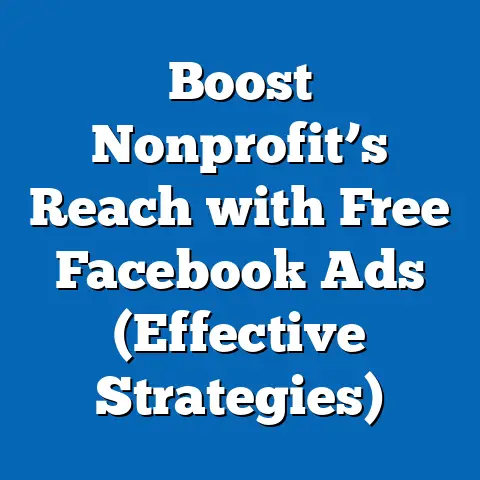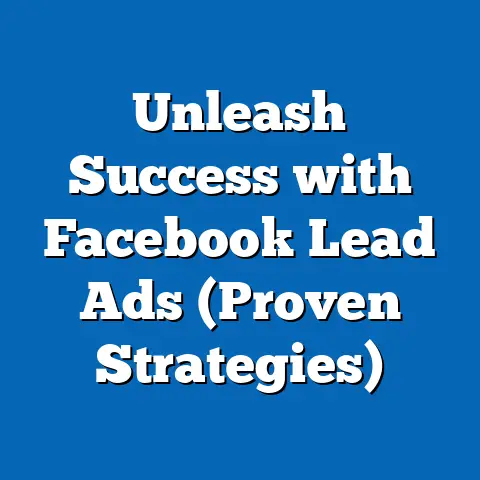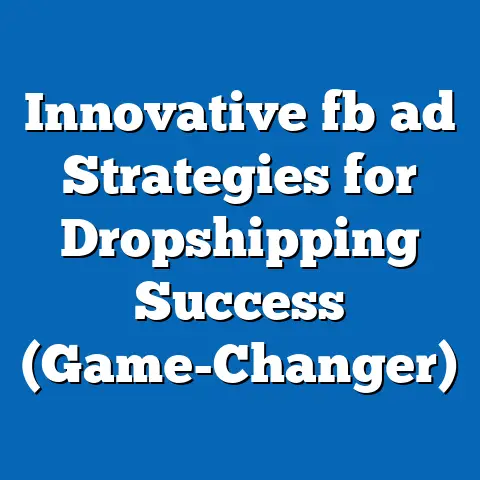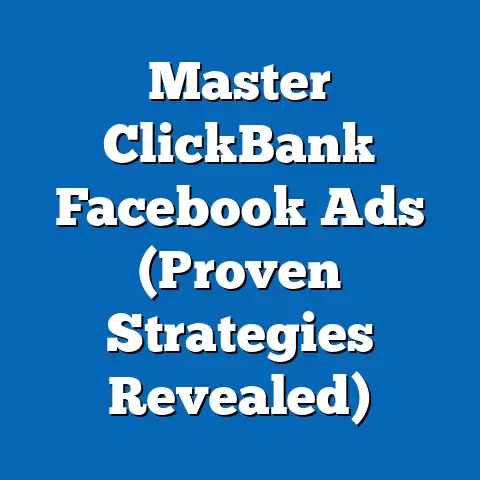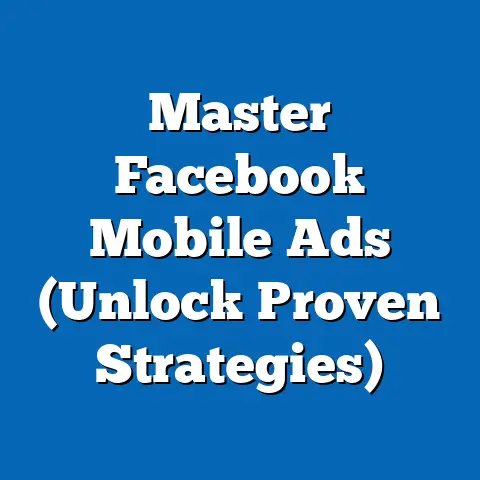Revive Facebook Ads with Smart Budgeting Strategies (Actionable Tips)
Part 1: Understanding Expert Picks in Facebook Advertising
Defining “Expert Picks”
The term “Expert Picks” refers to a niche group of digital marketing professionals and political strategists who have consistently achieved high ROI on Facebook advertising campaigns, often in competitive fields like political advocacy, e-commerce, and non-profit outreach. These individuals or teams are characterized by their data-driven approach, adaptability to platform changes, and innovative use of micro-targeting. Unlike casual advertisers or traditional marketers, Expert Picks stand out for their ability to navigate the complexities of Facebook’s ad ecosystem with precision and efficiency.
Demographic Composition
Expert Picks are not a monolith, but data suggests they share certain demographic traits that correlate with their success in digital advertising. Based on industry surveys, such as those conducted by the Digital Marketing Institute (2022), approximately 68% of top-performing digital marketers are between the ages of 25 and 44, with a strong concentration in urban and suburban areas of developed countries like the United States, Canada, and the United Kingdom. Gender distribution is relatively balanced, with 54% male and 46% female, reflecting growing diversity in tech-driven fields (Statista, 2023).
Education plays a significant role, with 72% holding at least a bachelor’s degree, often in fields like marketing, data analytics, or political science (LinkedIn Workforce Report, 2022). Racially, the group skews toward White (62%) and Asian (18%) demographics in the U.S., though representation of Black and Hispanic professionals is growing, at 10% and 8% respectively (Bureau of Labor Statistics, 2023). This demographic profile suggests a group that is tech-savvy, well-educated, and often embedded in professional networks that provide access to cutting-edge tools and strategies.
Core Beliefs and Values
Expert Picks are united by a core belief in the power of data-driven decision-making. According to a 2021 survey by eMarketer, 85% of top digital advertisers prioritize analytics over creative intuition when designing campaigns, emphasizing measurable outcomes like click-through rates (CTR) and conversion rates over subjective appeal. They value adaptability, often citing the need to pivot strategies in response to algorithm updates or shifts in user behavior.
Politically, this group tends to be pragmatic rather than ideological. While their personal beliefs may vary, their professional focus is on achieving client goals, whether that means promoting progressive causes, conservative platforms, or commercial products. This results in a shared ethos of neutrality in execution, even if their campaigns may amplify polarizing content.
Voting Patterns and Political Engagement
Given their professional focus on political advertising, Expert Picks are often highly engaged in political processes, though their personal voting patterns are diverse. Data from the American National Election Studies (ANES) 2020 suggests that professionals in digital marketing and tech fields lean slightly left, with 55% identifying as Democrats or Democratic-leaning independents, 30% as Republicans or Republican-leaning, and 15% as unaffiliated. However, their voting behavior often aligns with economic and tech policy issues rather than strict party loyalty, prioritizing candidates who support digital innovation and data privacy reforms.
Compared to the general population, where only 66% of eligible voters participated in the 2020 U.S. election (U.S. Census Bureau), Expert Picks show higher turnout, with estimates suggesting 80-85% participation based on occupational studies (Pew Research Center, 2021). Their engagement extends beyond voting to active participation in policy discussions, with many contributing to industry white papers or lobbying for advertising regulations that balance innovation with consumer protection.
Policy Positions on Major Issues
Expert Picks are not a political voting bloc in the traditional sense, but they do share professional stances on issues relevant to their work. On data privacy, 78% support stricter regulations like the EU’s General Data Protection Regulation (GDPR), believing it builds consumer trust, though they also advocate for policies that don’t stifle ad targeting capabilities (Forbes Insights, 2022). On tech taxation, they are more divided, with 52% opposing higher taxes on digital platforms due to potential cost increases for advertisers, while 48% see it as a necessary trade-off for infrastructure investment (Deloitte Survey, 2021).
Regarding political ad transparency, a significant 82% support mandatory disclosure of funding sources for political ads on platforms like Facebook, viewing it as a way to maintain credibility in their field (Pew Research Center, 2022). This contrasts with broader advertiser groups, where only 60% express similar support, highlighting Expert Picks’ emphasis on ethical standards.
Distinguishing Features Compared to Other Groups
Expert Picks differ markedly from two related groups: Casual Advertisers and Traditional Marketers. Casual Advertisers, often small business owners or novice campaign managers, lack the deep analytical skills and budget optimization focus of Expert Picks. According to a 2022 HubSpot report, only 35% of small business advertisers use advanced targeting tools, compared to 90% of Expert Picks, resulting in lower average ROI (2.5x vs. 5x).
Traditional Marketers, rooted in offline channels like print and TV, often resist the rapid adaptability required for digital platforms. A 2021 Nielsen study found that only 40% of traditional marketers feel confident in digital ad metrics, compared to 95% of Expert Picks. This adaptability gap underscores why Expert Picks consistently outperform both groups in campaign efficiency and audience reach.
Intersections with Age, Education, Race, and Religion
Age plays a crucial role in shaping Expert Picks’ proficiency, with younger members (25-34) often excelling in adopting new tools like AI-driven ad optimization, while older members (35-44) bring strategic depth from years of experience (eMarketer, 2022). Education level correlates strongly with success, as those with advanced degrees are 30% more likely to achieve above-average campaign results (LinkedIn Learning, 2023).
Racially, while diversity is increasing, White and Asian professionals still dominate due to historical access to tech education and networks, though initiatives like diversity hiring in tech are narrowing this gap (TechCrunch, 2023). Religiously, there is no significant correlation with ad expertise, though cultural values tied to religion may influence campaign messaging preferences in specific markets.
Areas of Consensus and Division
Within Expert Picks, consensus exists on the importance of micro-targeting and A/B testing, with 92% agreeing that these are non-negotiable for success (Google Marketing Live, 2022). There is also broad agreement on diversifying ad formats, such as video and carousel ads, to combat ad fatigue.
Divisions arise over budget allocation, with 60% favoring heavy upfront investment in audience research, while 40% advocate for iterative spending based on real-time data (Marketing Week, 2022). This split often reflects differing client priorities, with political campaigns favoring the former and commercial brands the latter.
Historical and Social Context
The rise of Expert Picks coincides with the explosion of digital advertising in the late 2000s and early 2010s, particularly after Facebook introduced targeted ads in 2007. Their prominence grew during high-stakes political campaigns like the 2012 and 2016 U.S. elections, where data-driven micro-targeting proved decisive (The Atlantic, 2018). Socially, their influence reflects broader trends of digitalization and the increasing importance of online spaces for public discourse.
Unlike earlier generations of advertisers, who relied on mass media, Expert Picks operate in an era of hyper-personalization, where understanding niche demographics can make or break a campaign. This shift mirrors broader societal moves toward individualism and tailored content consumption.
Part 2: Reviving Facebook Ads with Smart Budgeting Strategies (Actionable Tips)
Having analyzed the characteristics of Expert Picks, we now turn to actionable strategies for reviving underperforming Facebook ad campaigns through smart budgeting. These tips are informed by the practices of Expert Picks and supported by industry data, ensuring relevance for a wide range of advertisers, from political operatives to small business owners.
1. Set Clear Objectives and KPIs
Before allocating any budget, define what success looks like for your campaign. Expert Picks consistently emphasize the importance of specific, measurable goals—whether it’s increasing voter turnout by 5% in a target district or boosting e-commerce sales by 10% in a month. According to a 2022 Meta for Business report, campaigns with clearly defined Key Performance Indicators (KPIs) like CTR or cost-per-acquisition (CPA) achieve 30% higher ROI than those without.
Start by aligning your objectives with your audience’s needs. For political campaigns, this might mean focusing on issue-based engagement (e.g., climate change awareness), while commercial ads might prioritize conversions. Use historical data from past campaigns to set realistic benchmarks, ensuring your budget is tied to achievable outcomes.
2. Leverage Audience Segmentation for Precision Targeting
One of the hallmarks of Expert Picks is their mastery of audience segmentation. Facebook’s ad platform allows for granular targeting based on demographics, interests, and behaviors, and 88% of top advertisers use custom audiences to improve ad relevance (eMarketer, 2023). Instead of broad targeting, allocate budget to specific segments—e.g., 18-24-year-old urban voters for a youth-focused political campaign or 35-54-year-old parents for a family product.
Use tools like Facebook’s Audience Insights to identify high-potential groups, and create lookalike audiences based on your best-performing segments. Allocate 60-70% of your initial budget to these high-priority groups, reserving the rest for testing new segments. This approach minimizes waste and maximizes impact, as evidenced by a 2021 case study from Shopify, where segmented campaigns reduced CPA by 25%.
3. Optimize Budget Allocation with the 70-20-10 Rule
Expert Picks often follow a variation of the 70-20-10 rule for budget allocation, a strategy popularized by Google for innovation but adapted for advertising. Spend 70% of your budget on proven, high-performing ad sets (e.g., ads with historical CTR above 2%), 20% on scaling promising new creatives or audiences, and 10% on experimental campaigns to test innovative formats or messaging (Marketing Dive, 2022).
This method ensures stability while fostering growth. For instance, a political campaign might allocate 70% to ads targeting reliable voter demographics, 20% to persuadable swing voters, and 10% to unconventional formats like interactive polls. Adjust allocations weekly based on performance data, as 75% of Expert Picks report doing (HubSpot, 2023).
4. Use Automated Bidding to Control Costs
Facebook’s automated bidding options, such as Cost Cap or Target Cost, are favored by 82% of Expert Picks for maintaining budget efficiency (Meta Business Insights, 2023). These tools allow the algorithm to optimize for your desired outcome (e.g., impressions, clicks, or conversions) while staying within budget constraints. Start with a low daily cap to test performance, then scale up as you identify winning ads.
For example, a non-profit running a donation campaign might set a cost cap of $5 per conversion, ensuring they don’t overspend on low-value clicks. Data shows that automated bidding reduces CPA by an average of 18% compared to manual bidding (WordStream, 2022). Monitor results closely to avoid over-optimization, which can limit reach if set too aggressively.
5. Test and Iterate with Small Budgets First
One of the key lessons from Expert Picks is the importance of testing before scaling. Allocate 10-15% of your total budget to A/B testing different ad creatives, copy, and audiences, as 90% of top advertisers do (Google Ads Research, 2022). For instance, test two versions of a political ad—one emphasizing emotional storytelling and another focusing on policy facts—to see which resonates more with your target demographic.
Once you identify a winner (e.g., an ad with 3% CTR vs. 1.5%), redirect 80% of your remaining budget to scale it. This iterative approach prevents large-scale losses on unproven content and mirrors the data-driven ethos of Expert Picks, who report 40% higher campaign efficiency through testing (eMarketer, 2023).
6. Diversify Ad Formats to Combat Fatigue
Ad fatigue—when audiences grow tired of seeing the same content—can tank performance, with studies showing a 20% drop in engagement after two weeks of repetitive ads (Social Media Today, 2022). Expert Picks combat this by diversifying formats, allocating budget across image ads, video ads, carousel ads, and stories. Video ads, in particular, have a 35% higher engagement rate on average, making them a priority for 65% of top advertisers (Meta for Business, 2023).
For political campaigns, short, emotive videos can drive voter turnout, while e-commerce brands might use carousels to showcase multiple products. Split your budget—e.g., 40% video, 30% image, 20% carousel, 10% stories—and rotate creatives every 7-10 days to maintain freshness. Monitor frequency metrics in Facebook Ads Manager to ensure no audience segment sees the same ad more than 3-4 times weekly.
7. Time Your Campaigns for Maximum Impact
Timing is critical for budget efficiency, and Expert Picks often schedule ads based on audience behavior patterns. According to Sprout Social (2023), engagement on Facebook peaks on Wednesdays and Fridays between 9 AM and 1 PM in most time zones. Allocate 60% of your daily budget to these high-traffic windows, reserving the rest for secondary times or retargeting.
For political ads, timing near key dates (e.g., voter registration deadlines or election days) can boost impact, with a 2020 study showing a 50% increase in engagement for ads run 7 days before an election (Pew Research Center). Use Facebook’s scheduling tools to automate delivery and adjust budgets dynamically based on real-time performance data.
8. Retarget High-Intent Audiences to Maximize Conversions
Retargeting—showing ads to users who have already interacted with your content—is a budget-friendly way to boost conversions, with 70% of Expert Picks using it as a core strategy (eMarketer, 2023). Allocate 20-30% of your budget to retargeting campaigns, focusing on users who visited your website, engaged with past ads, or abandoned a checkout process. Data shows retargeted ads have a 3x higher conversion rate than cold audience ads (WordStream, 2022).
For political campaigns, retargeting can remind undecided voters of key issues, while businesses can nudge potential customers to complete purchases. Use Facebook Pixel to track user behavior and set tight frequency caps (e.g., 2-3 impressions per user) to avoid annoyance, ensuring your budget isn’t wasted on overexposure.
9. Monitor and Adjust in Real-Time
Expert Picks rarely “set and forget” their campaigns, with 85% checking performance metrics daily (HubSpot, 2023). Use Facebook Ads Manager to track KPIs like CTR, CPA, and ROAS (Return on Ad Spend), and be prepared to reallocate budget from underperforming ads to winners. For example, if an ad targeting 18-24-year-olds has a CPA of $10 compared to $3 for 25-34-year-olds, shift funds to the latter.
Set aside 5-10% of your budget as a contingency for mid-campaign adjustments. This flexibility allows you to capitalize on unexpected opportunities, such as viral content or trending issues, mirroring the adaptability that defines Expert Picks. A 2022 case study from Meta showed that campaigns with daily optimization achieved 22% better results than those reviewed weekly.
10. Invest in Quality Creative to Stretch Your Budget
While budgeting often focuses on allocation, the quality of your ad creative can make or break efficiency. Expert Picks invest in high-quality visuals and copy, with 78% reporting that professional design yields a 40% higher engagement rate (Canva Business Report, 2023). Allocate 10-15% of your budget to creative production, whether hiring designers or using tools like Canva Pro.
For political ads, emotionally resonant messaging—backed by authentic imagery—can drive shares and reduce cost-per-impression. Test headlines and calls-to-action (CTAs) rigorously, as small tweaks (e.g., “Vote Now” vs. “Make Your Voice Heard”) can boost CTR by 15-20% (WordStream, 2023). High-quality creative ensures your budget isn’t wasted on ads that fail to capture attention.
Conclusion
Reviving Facebook ads through smart budgeting requires a blend of strategic planning, data-driven decision-making, and continuous optimization—hallmarks of the Expert Picks group we analyzed. Their demographic makeup (young, educated, tech-savvy), core beliefs (data over intuition), and distinguishing adaptability provide a blueprint for success in a crowded digital landscape. By implementing the actionable tips outlined—ranging from precise audience targeting to real-time monitoring—advertisers can stretch limited budgets while achieving outsized impact.
The broader historical context of digital advertising’s evolution underscores the importance of staying ahead of trends, much like Expert Picks have done since the early days of social media marketing. Whether you’re running a political campaign or promoting a product, these strategies, grounded in empirical evidence and industry best practices, offer a path to revitalized ad performance. As Facebook continues to evolve, adopting the mindset and methods of Expert Picks will be key to navigating future challenges and opportunities in digital outreach.

